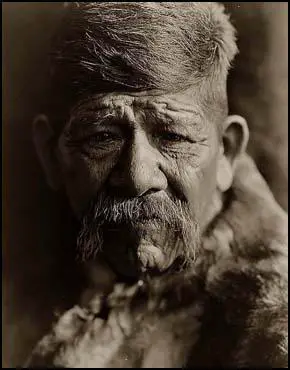Yokut
The Yokut lived in California in the San Joaquin Valley and along the western slopes of the Sierra Nevada Mountains. According to Evelyn Wolfson: "A species of bullrush, called tule, filled the marshland and supplied the Yokut with material for covering their houses, making clothes, and weaving baskets. The rich food resources of the area allowed them to build large, permanent villages near the water. They built rows of round, steep-roofed houses which they framed with posts and covered with tule mats. Up to ten families lived in each house."
Stephen Powers argues in his book, Tribes of California (1876): "Every village consists of a single row of wigwams, conical or wedge-shaped, generally made of Tule, and just enough hollowed out within so that the inmates may sleep with the head higher than the feet, all in perfect alignment, and with a continuous awning of brushwood stretching along in front." Powers also pointed out that Elk were used for making moccasins: "Their method of tanning was by means of brain-water. They dried the brains of deer and other animals, reduced it to powder, put the powder into water, and soaked the skins therein - a process which answered tolerably well. The graining was done with flints. Elk-hide, being very thick, made the best sandals."
Robert F. Heizer points out that they built tule rafts which would carry two or three people. "Though of simple construction, such rafts served to take fishermen and waterfowl hunters beyond the reeds to open water. They were propelled with long poles, which were pushed into the shallow lake bottom."

The Yokut used to set fire to the underbrush and then were able to collect great quantities of grasshoppers and caterpillars already roasted. However, they never killed rattlesnakes because they considered them sacred. According to Stephen Powers: "The coyote also moved among them with perfect impunity, for he is revered as the creator of the universe."
According to the authors of The Natural World of the California Indians (1980), the Yokuts, along with the Costanoans and the Gabrielino, tobacco played an important role in tribal life: "Tobacco was mixed with lime from seashells and eaten. A kind of intoxication resulted, though the main effect seems to have been vomiting."
The Mission San Francisco de Asís was established by Francisco Palóu, a student of Junipero Serra, in San Francisco on 29th June, 1776. According to Tracy Salcedo-Chouree, the author of California's Missions and Presidios (2005): "The padres would harvest for souls and laborers with questionable success. Indians from the more distant rancherias of the Coast Miwok, the Wappo, the Patwin, and the Yokut would find themselves living at one time or another at the mission, where they would work at becoming good Christians as well as good builders, farmers, weavers, and tanners, and, from many accounts, long to return to their native homes and lifestyles. They would also find themselves plagued by whippings, hunger, and disease.... But eventually some Indians did convert, swelling the mission's population to nearly 1,000 by 1794. Runaways and disease kept the numbers in check, however: A measles epidemic struck in 1795, killing a large number of neophytes, and more than 200 fled mission in its aftermath." Mission records show that by 1842 only 37 Native Americans were left in the settlement."
Alfred L. Kroeber put the 1770 population of the Yokut at 18,000. However, Robert F. Heizer, believes that 70,000 would be closer to the truth. However, with the arrival of the pioneers in the 19th century, numbers declined dramatically and research suggests that population of the Yokut had fallen to 600 by 1910.
